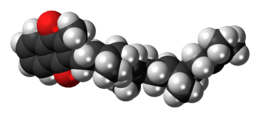Menatetrenone
|
| |
 | |
| Clinical data | |
|---|---|
| AHFS/Drugs.com | International Drug Names |
| Routes of administration | Oral |
| ATC code | none |
| Identifiers | |
| |
| Synonyms | 3-methyl-2-[(2Z,6E,10E)-3,7,11,15-tetramethylhexadeca-2,6,10,14-tetraenyl]naphthalene-1,4-dione |
| CAS Number |
863-61-6 |
| PubChem (CID) | 5282367 |
| ChemSpider |
4445530 |
| UNII |
27Y876D139 |
| KEGG |
D00100 |
| ChEBI |
CHEBI:78277 |
| Chemical and physical data | |
| Formula | C31H40O2 |
| Molar mass | 444.648 g/mol |
| 3D model (Jmol) | Interactive image |
| |
| |
| | |
Menatetrenone (INN), also known as MK-4, is a vitamin K compound used as a hemostatic agent, and also as adjunctive therapy for the pain of osteoporosis. Menatetrenone is one of the nine forms of vitamin K2.[1]
MK-4 is produced via conversion of vitamin K1 in the body, in the testes, pancreas and arterial walls.[2] While major questions still surround the biochemical pathway for the transformation of vitamin K1 to MK-4, studies demonstrate the conversion is not dependent on gut bacteria, occurring in germ-free rats[3][4] and in parenterally-administered K1 in rats.[5][6] In fact, tissues that accumulate high amounts of MK-4 have a remarkable capacity to convert up to 90% of the available K1 into MK-4.[7][8]
MK-4 is marketed for the osteoporosis indication in Japan by Eisai Co., under the trade name Glakay.
See also
- Vitamin K
- Phylloquinone (vitamin K1)
References
- ↑ Iwamoto J, Takeda T, Sato Y (December 2006). "Menatetrenone (vitamin K2) and bone quality in the treatment of postmenopausal osteoporosis". Nutr. Rev. 64 (12): 509–17. doi:10.1111/j.1753-4887.2006.tb00184.x. PMID 17274493.
- ↑ Shearer, Shearer MJ; Newman P. (2008). "Metabolism and cell biology of vitamin K". Thrombosis and Haemostasis. 100: 530–547. doi:10.1160/TH08-03-0147. PMID 18841274.
- ↑ Davidson, RT; Foley AL; Engelke JA; Suttie JW (1998). "Conversion of Dietary Phylloquinone to Tissue Menaquinone-4 in Rats is Not Dependent on Gut Bacteria1". Journal of Nutrition. 128 (2): 220–223. PMID 9446847.
- ↑ Ronden, JE; Drittij-Reijnders M-J, Vermeer C, Thijssen HHW. (1998). "Intestinal flora is not an intermediate in the phylloquinone-menaquinone-4 conversion in the rat". Biochimica et Biophysica Acta (BBA) - General Subjects. 1379 (1): 69–75. doi:10.1016/S0304-4165(97)00089-5. PMID 9468334. Cite uses deprecated parameter
|coauthors=(help) - ↑ Thijssen, HHW; Drittij-Reijnders MJ (1994). "Vitamin K distribution in rat tissues: dietary phylloquinone is a source of tissue menaquinone-4". British Journal of Nutrition. 72 (3): 415–425. doi:10.1079/BJN19940043. PMID 7947656.
- ↑ Will, BH; Usui Y; Suttie JW (1992). "Comparative Metabolism and Requirement of Vitamin K in Chicks and Rats". Journal of Nutrition. 122 (12): 2354–2360. PMID 1453219.
- ↑ Davidson, RT; Foley AL; Engelke JA; Suttie JW (1998). "Conversion of Dietary Phylloquinone to Tissue Menaquinone-4 in Rats is Not Dependent on Gut Bacteria". Journal of Nutrition. 128 (2): 220–223. PMID 9446847.
- ↑ Ronden, JE; Drittij-Reijnders M-J; Vermeer C; Thijssen HHW (1998). "Intestinal flora is not an intermediate in the phylloquinone-menaquinone-4 conversion in the rat". Biochimica et Biophysica Acta (BBA) - General Subjects. 1379 (1): 69–75. doi:10.1016/S0304-4165(97)00089-5. PMID 9468334.
External links